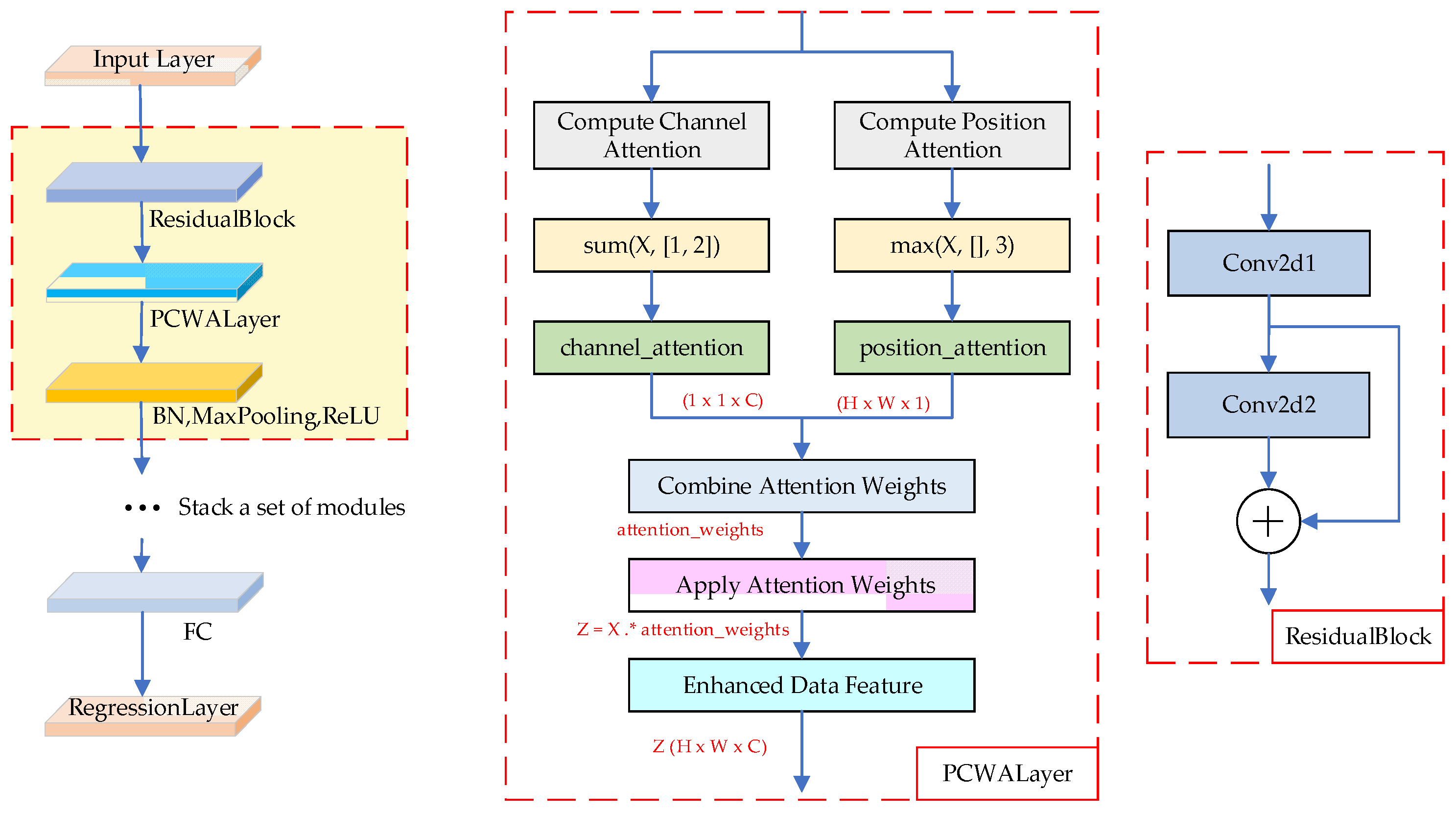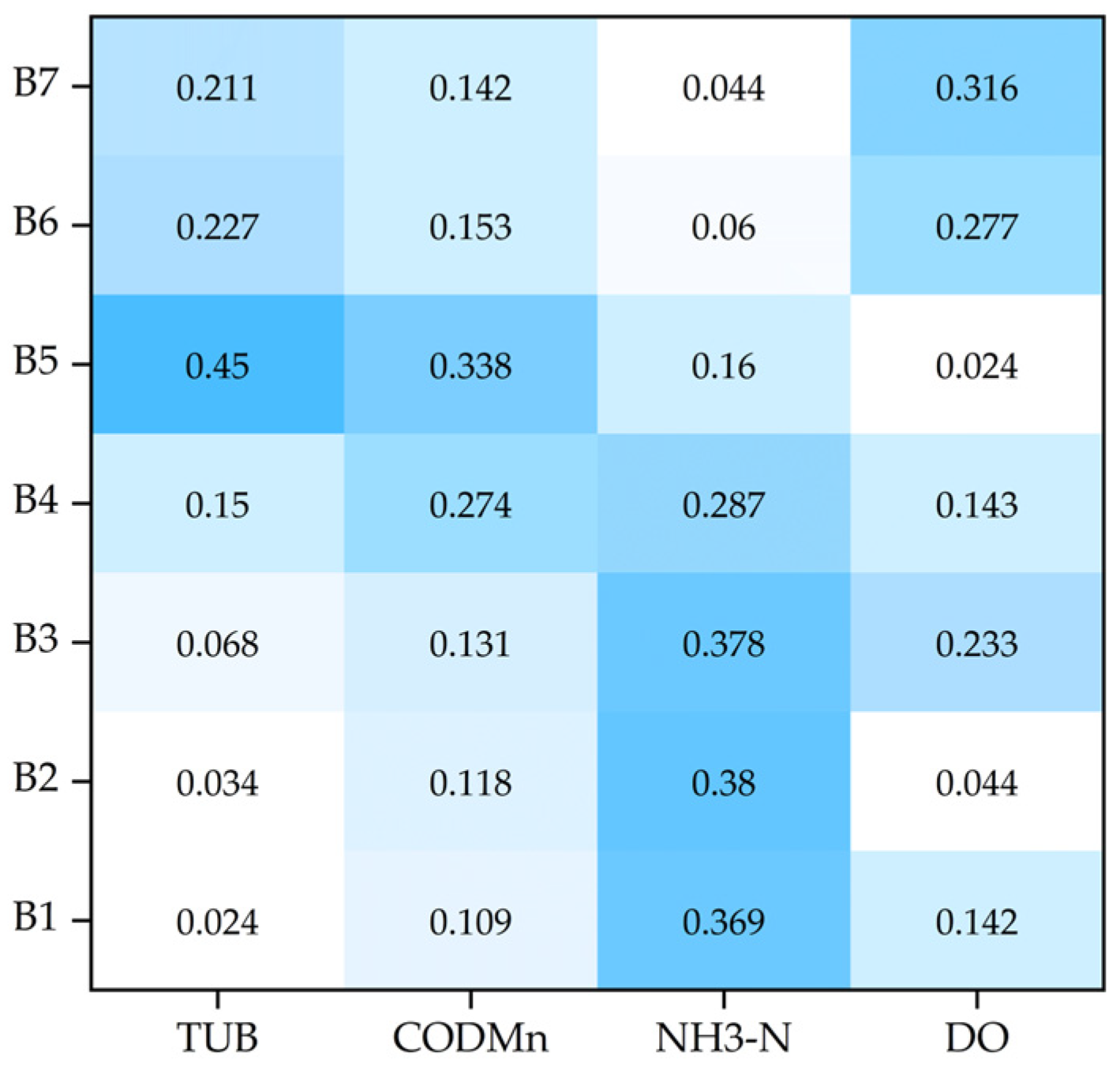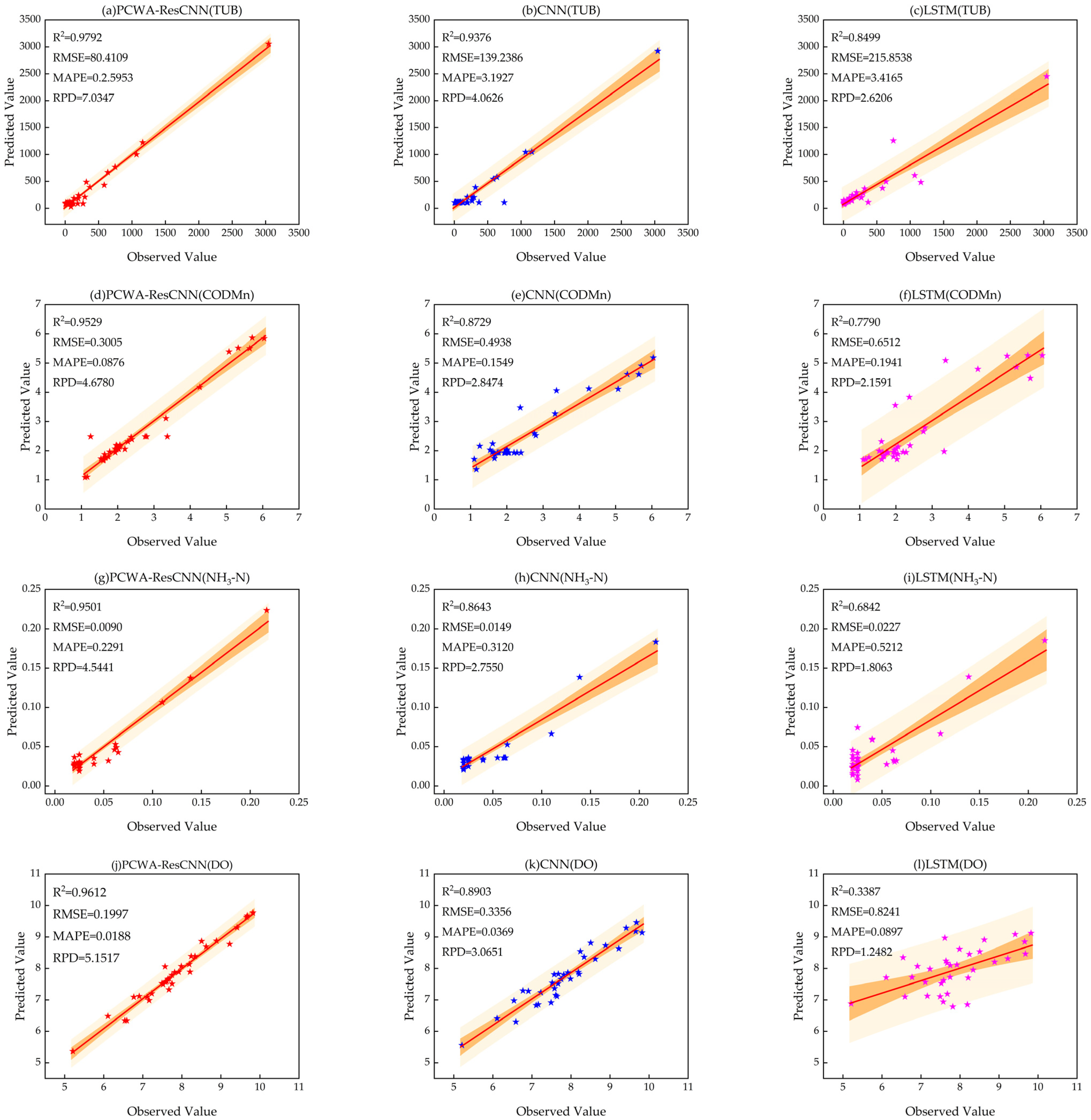Enhanced Water Quality Inversion in the Ningxia Yellow River Basin Using a Hybrid PCWA-ResCNN Model: Insights from Landsat-8 Data
Abstract
1. Introduction
2. Materials and Methods
2.1. Research Area
2.2. Data and Processing
2.2.1. Water Quality Monitoring Data
2.2.2. Remote Sensing Image Data
2.2.3. Remote Sensing Image Preprocessing
2.3. Methods
2.3.1. PCWA-ResCNN Model Construction
2.3.2. CNN Model Construction
2.3.3. LSTM Model Construction
2.4. Correlation Analysis
2.5. Statistical Evaluation of Indicators
3. Results
3.1. Prediction Results and Analysis of Water Quality Parameters
3.2. Spatiotemporal Analysis of Water Quality
4. Discussion
4.1. Advantages
4.2. Limitations
5. Conclusions
Author Contributions
Funding
Institutional Review Board Statement
Informed Consent Statement
Data Availability Statement
Acknowledgments
Conflicts of Interest
References
- Galgani, L.; Loiselle, S.A. Plastic pollution impacts on marine carbon biogeochemistry. Environ. Pollut. 2021, 268, 115598. [Google Scholar] [CrossRef] [PubMed]
- Olaka, L.A.; Ogutu, J.O.; Said, M.Y.; Oludhe, C. Projected climatic and hydrologic changes to Lake Victoria Basin Rivers under three RCP emission scenarios for 2015–2100 and impacts on the water sector. Water 2019, 11, 1449. [Google Scholar] [CrossRef]
- Yang, W.; Yao, J.; He, Y.; Huang, Y.; Liu, H.; Zhi, Y.; Qian, S.; Yan, X.; Jian, S.; Li, W. Nitrogen removal enhanced by benthic bioturbation coupled with biofilm formation: A new strategy to alleviate freshwater eutrophication. J. Environ. Manag. 2021, 292, 112814. [Google Scholar] [CrossRef] [PubMed]
- Moss, B. Cogs in the endless machine: Lakes, climate change and nutrient cycles: A review. Sci. Total Environ. 2012, 434, 130–142. [Google Scholar] [CrossRef] [PubMed]
- Yin, D.; Wang, L.; Zhu, Z.; Clark, S.S.; Cao, Y.; Besek, J.; Dai, N. Water quality related to Conservation Reserve Program (CRP) and cropland areas: Evidence from multi-temporal remote sensing. Int. J. Appl. Earth Obs. Geoinf. 2021, 96, 102272. [Google Scholar] [CrossRef]
- Schaeffer, B.A.; Schaeffer, K.G.; Keith, D.; Lunetta, R.S.; Conmy, R.; Gould, R.W. Barriers to adopting satellite remote sensing for water quality management. Int. J. Remote Sens. 2013, 34, 7534–7544. [Google Scholar] [CrossRef]
- Liu, P.; Wang, J.; Sangaiah, A.K.; Xie, Y.; Yin, X. Analysis and prediction of water quality using LSTM deep neural networks in IoT environment. Sustainability 2019, 11, 2058. [Google Scholar] [CrossRef]
- Cui, Y.; Yan, Z.; Wang, J.; Hao, S.; Liu, Y. Deep learning–based remote sensing estimation of water transparency in shallow lakes by combining Landsat 8 and Sentinel 2 images. Environ. Sci. Pollut. Res. 2022, 29, 4401–4413. [Google Scholar] [CrossRef]
- He, Y.; Gong, Z.; Zheng, Y.; Zhang, Y. Inland reservoir water quality inversion and eutrophication evaluation using BP neural network and remote sensing imagery: A case study of Dashahe reservoir. Water 2021, 13, 2844. [Google Scholar] [CrossRef]
- Yang, S.; Zhong, S.; Chen, K. W-WaveNet: A multi-site water quality prediction model incorporating adaptive graph convolution and CNN-LSTM. PLoS ONE 2024, 19, e0276155. [Google Scholar] [CrossRef]
- Ni, Q.; Cao, X.; Tan, C.; Peng, W.; Kang, X. An improved graph convolutional network with feature and temporal attention for multivariate water quality prediction. Environ. Sci. Pollut. Res. 2023, 30, 11516–11529. [Google Scholar] [CrossRef] [PubMed]
- Syariz, M.A.; Lin, C.H.; Nguyen, M.V.; Jaelani, L.M.; Blanco, A.C. WaterNet: A convolutional neural network for chlorophyll-a concentration retrieval. Remote Sens. 2020, 12, 1966. [Google Scholar] [CrossRef]
- Sagan, V.; Peterson, K.T.; Maimaitijiang, M.; Sidike, P.; Sloan, J.; Greeling, B.A.; Maalouf, S.; Adams, C. Monitoring inland water quality using remote sensing: Potential and limitations of spectral indices, bio-optical simulations, machine learning, and cloud computing. Earth-Sci. Rev. 2020, 205, 103187. [Google Scholar] [CrossRef]
- Zhao, Y.; Yu, T.; Hu, B.; Zhang, Z.; Liu, Y.; Liu, X.; Liu, H.; Liu, J.; Wang, X.; Song, S. Retrieval of water quality parameters based on near-surface remote sensing and machine learning algorithm. Remote Sens. 2022, 14, 5305. [Google Scholar] [CrossRef]
- Yang, H.; Du, Y.; Zhao, H.; Chen, F. Water quality Chl-a inversion based on spatio-temporal fusion and convolutional neural network. Remote Sens. 2022, 14, 1267. [Google Scholar] [CrossRef]
- Harvey, E.T.; Kratzer, S.; Philipson, P. Satellite-based water quality monitoring for improved spatial and temporal retrieval of chlorophyll-a in coastal waters. Remote Sens. Environ. 2015, 158, 417–430. [Google Scholar] [CrossRef]
- Chu, H.J.; He, Y.C. Remote sensing water quality inversion using sparse representation: Chlorophyll-a retrieval from Sentinel-2 MSI data. Remote Sens. Appl. Soc. Environ. 2023, 31, 101006. [Google Scholar] [CrossRef]
- Xue, Y.; Zhu, L.; Zou, B.; Wen, Y.-M.; Long, Y.-H.; Zhou, S.-L. Research on inversion mechanism of chlorophyll—A concentration in water bodies using a Convolutional Neural Network model. Water 2021, 13, 664. [Google Scholar] [CrossRef]
- Zhang, H.; Xue, B.; Wang, G.; Zhang, X.; Zhang, Q. Deep learning-based water quality retrieval in an impounded lake using landsat 8 imagery: An application in Dongping lake. Remote Sens. 2022, 14, 4505. [Google Scholar] [CrossRef]
- Parra, L.; Ahmad, A.; Sendra, S.; Lloret, J.; Lorenz, P. Combination of Machine Learning and RGB Sensors to Quantify and Classify Water Turbidity. Chemosensors 2024, 12, 34. [Google Scholar] [CrossRef]
- Kuang, L.; Shi, P.; Hua, C.; Chen, B.; Zhu, H. An enhanced extreme learning machine for dissolved oxygen prediction in wireless sensor networks. IEEE Access 2020, 8, 198730–198739. [Google Scholar] [CrossRef]
- Ren, J.; Zhu, Q.; Wang, C. Edge Computing for Water Quality Monitoring Systems. Mob. Inf. Syst. 2022, 2022, 5056606. [Google Scholar] [CrossRef]
- Yigit Avdan, Z.; Kaplan, G.; Goncu, S.; Avdan, U. Monitoring the water quality of small water bodies using high-resolution remote sensing data. ISPRS Int. J. Geo-Inf. 2019, 8, 553. [Google Scholar] [CrossRef]
- Brierley, G.J.; Han, M.; Li, X.; Li, Z.; Huang, H.Q. Geo-eco-hydrology of the Upper Yellow River. Wiley Interdiscip. Rev. Water 2022, 9, e1587. [Google Scholar] [CrossRef]
- Wu, N.; Liu, S.M.; Zhang, G.L.; Zhang, H.M. Anthropogenic impacts on nutrient variability in the lower Yellow River. Sci. Total Environ. 2021, 755, 142488. [Google Scholar] [CrossRef]
- HJ 915-2017; Technical Specifications for Automatic Monitoring of Surface Water. People’s Republic of China: Beijing, China, 2018.
- Kuhn, C.; de Matos Valerio, A.; Ward, N.; Loken, L.; Sawakuchi, H.O.; Kampel, M.; Richey, J.; Stadler, P.; Crawford, J.; Striegl, R.; et al. Performance of Landsat-8 and Sentinel-2 surface reflectance products for river remote sensing retrievals of chlorophyll-a and turbidity. Remote Sens. Environ. 2019, 224, 104–118. [Google Scholar] [CrossRef]
- Wu, H.; Guo, Q.; Zang, J.; Qiao, Y.; Zhu, L.; He, Y. Study on Water Quality Parameter Inversion based on Landsat 8 and Measured Data. Remote Sens. Technol. Appl. 2021, 36, 898–907. [Google Scholar]
- Holden, C.E.; Woodcock, C.E. An analysis of Landsat 7 and Landsat 8 underflight data and the implications for time series investigations. Remote Sens. Environ. 2016, 185, 16–36. [Google Scholar] [CrossRef]
- Guo, J.; Yang, J.; Yue, H.; Hou, C.; Li, K. Landsat-8 OLI multispectral image dehazing based on optimized atmospheric scattering model. IEEE Trans. Geosci. Remote Sens. 2020, 59, 10255–10265. [Google Scholar] [CrossRef]
- GB 3838-2002; Environmental quality standards for surface water. People’s Republic of China: Beijing, China, 2002.
- Liu, Y.L.; Zheng, Y.A. Water quality assessment and spatial-temporal variation analysis in Yellow River Basin. Huanjing Kexue 2022, 43, 1332–1345. [Google Scholar]
- Quan, J.; Xu, Y.; Ma, T.; Wilson, J.P.; Zhao, N.; Ni, Y. Improving surface water quality of the Yellow River Basin due to anthropogenic changes. Sci. Total Environ. 2022, 836, 155607. [Google Scholar] [CrossRef] [PubMed]
- Maier, P.M.; Keller, S.; Hinz, S. Deep learning with WASI simulation data for estimating chlorophyll a concentration of inland water bodies. Remote Sens. 2021, 13, 718. [Google Scholar] [CrossRef]
- Aptoula, E.; Ariman, S. Chlorophyll-a retrieval from sentinel-2 images using convolutional neural network regression. IEEE Geosci. Remote Sens. Lett. 2021, 19, 6002605. [Google Scholar] [CrossRef]
- Miao, Q.; Pan, B.; Wang, H.; Hsu, K.; Sorooshian, S. Improving monsoon precipitation prediction using combined convolutional and long short term memory neural network. Water 2019, 11, 977. [Google Scholar] [CrossRef]
- Tran, H.; Leonarduzzi, E.; De la Fuente, L.; Hull, R.B.; Bansal, V.; Chennault, C.; Gentine, P.; Melchior, P.; Condon, L.E.; Maxwell, R.M. Development of a deep learning emulator for a distributed groundwater–surface water model: ParFlow-ML. Water 2021, 13, 3393. [Google Scholar] [CrossRef]
- Xiao, Z.-H.; Wang, D.-M.; Wen, J.; Famg, H.-B.; Hu, Y.-X.; Xu, N. Overview of the ground application system of satellite-aviation-ground remote sensing data at home and abroad. Chin. J. Geomech. 2015, 21, 117–128. [Google Scholar]
- Liu, P. A survey of remote-sensing big data. Front. Environ. Sci. 2015, 3, 45. [Google Scholar] [CrossRef]
- Farahani, S.D.; Farahani, A.D. Machine learning models for predicting the performance of solar-geothermal desalination in different meteorological conditions. Ain Shams Eng. J. 2024, 15, 102591. [Google Scholar] [CrossRef]
- Kamath, V.; Renuka, A. Deep learning based object detection for resource constrained devices: Systematic review, future trends and challenges ahead. Neurocomputing 2023, 531, 34–60. [Google Scholar] [CrossRef]
- Oviedo, F.; Ferres, J.L.; Buonassisi, T.; Butler, K.T. Interpretable and explainable machine learning for materials science and chemistry. Acc. Mater. Res. 2022, 3, 597–607. [Google Scholar] [CrossRef]





| Sampling Point No. | Monitoring Section | Longitude | Latitude |
|---|---|---|---|
| 1 | Mahuang Ditch | 106°44′53″ | 39°22′35″ |
| 2 | Sand Lake | 106°20′52″ | 38°49′20″ |
| 3 | Pingluo Yellow River Bridge | 106°39′58″ | 38°48′46″ |
| 4 | Yingu Highway Bridge | 106°24′40″ | 38°21′33″ |
| 5 | Yazidang Reservoir | 106°32′12″ | 38°09′07″ |
| 6 | Yesheng Highway Bridge | 106°12′58″ | 38°08′14″ |
| 7 | Jinsha Bay | 105°55′34″ | 37°49′51″ |
| 8 | Xiangshan Lake | 105°12′01″ | 37°29′25″ |
| 9 | Zhongwei Xiaheyan | 105°07′27″ | 37°29′11″ |
| Sensor | Wave Band | Wavelength Range/μm | Spatial Resolution/m |
|---|---|---|---|
| OLI | B1-Coastal | 0.43–0.45 | 30 |
| OLI | B2-Blue | 0.45–0.51 | 30 |
| OLI | B3-Green | 0.53–0.59 | 30 |
| OLI | B4-Red | 0.64–0.67 | 30 |
| OLI | B5-NIR | 0.85–0.88 | 30 |
| OLI | B6-SWIR1 | 1.57–1.65 | 30 |
| OLI | B7-SWIR2 | 2.11–2.29 | 30 |
| OLI | B8-PAN | 0.50–0.68 | 15 |
| OLI | B9-Cirrus | 1.36–1.38 | 30 |
| TIRS | B10-TIRS1 | 10.60–11.19 | 100 |
| TIRS | B11-TIRS2 | 11.50–12.51 | 100 |
| Water Quality Parameter | Model | ||||
|---|---|---|---|---|---|
| TUB (NTU) | PCWA-ResCNN | 0.9792 | 80.4109 NTU | 2.5953 | 7.0347 |
| CNN | 0.9376 | 139.2386 NTU | 3.1927 | 4.0626 | |
| LSTM | 0.8499 | 215.8538 NTU | 3.4165 | 2.6206 | |
| CODMn (mg/L) | PCWA-ResCNN | 0.9529 | 0.3005 mg/L | 0.0876 | 4.6780 |
| CNN | 0.8729 | 0.4938 mg/L | 0.1549 | 2.8474 | |
| LSTM | 0.7790 | 0.6512 mg/L | 0.1941 | 2.1591 | |
| NH3-N (mg/L) | PCWA-ResCNN | 0.9501 | 0.0090 mg/L | 0.2291 | 4.5441 |
| CNN | 0.8643 | 0.0149 mg/L | 0.3120 | 2.7550 | |
| LSTM | 0.6842 | 0.0227 mg/L | 0.5212 | 1.8063 | |
| DO (mg/L) | PCWA-ResCNN | 0.9612 | 0.1997 mg/L | 0.0188 | 5.1517 |
| CNN | 0.8903 | 0.3356 mg/L | 0.0369 | 3.0651 | |
| LSTM | 0.3387 | 0.8241 mg/L | 0.0897 | 1.2482 |
| Evaluation Factor | Evaluation Level | ||||
|---|---|---|---|---|---|
| I | II | III | IV | V | |
| CODMn (mg/L)≤ | 2 | 4 | 6 | 10 | 15 |
| NH3-N (mg/L)≤ | 0.15 | 0.5 | 1 | 1.5 | 2 |
| DO (mg/L)≥ | 7.5 | 6 | 5 | 3 | 2 |
Disclaimer/Publisher’s Note: The statements, opinions and data contained in all publications are solely those of the individual author(s) and contributor(s) and not of MDPI and/or the editor(s). MDPI and/or the editor(s) disclaim responsibility for any injury to people or property resulting from any ideas, methods, instructions or products referred to in the content. |
© 2024 by the authors. Licensee MDPI, Basel, Switzerland. This article is an open access article distributed under the terms and conditions of the Creative Commons Attribution (CC BY) license (https://creativecommons.org/licenses/by/4.0/).
Share and Cite
Li, Q.; Guo, Z.; Li, J.; Li, X.; Ban, B. Enhanced Water Quality Inversion in the Ningxia Yellow River Basin Using a Hybrid PCWA-ResCNN Model: Insights from Landsat-8 Data. Appl. Sci. 2024, 14, 8264. https://doi.org/10.3390/app14188264
Li Q, Guo Z, Li J, Li X, Ban B. Enhanced Water Quality Inversion in the Ningxia Yellow River Basin Using a Hybrid PCWA-ResCNN Model: Insights from Landsat-8 Data. Applied Sciences. 2024; 14(18):8264. https://doi.org/10.3390/app14188264
Chicago/Turabian StyleLi, Qi, Zhonghua Guo, Jialong Li, Xiaojun Li, and Bo Ban. 2024. "Enhanced Water Quality Inversion in the Ningxia Yellow River Basin Using a Hybrid PCWA-ResCNN Model: Insights from Landsat-8 Data" Applied Sciences 14, no. 18: 8264. https://doi.org/10.3390/app14188264
APA StyleLi, Q., Guo, Z., Li, J., Li, X., & Ban, B. (2024). Enhanced Water Quality Inversion in the Ningxia Yellow River Basin Using a Hybrid PCWA-ResCNN Model: Insights from Landsat-8 Data. Applied Sciences, 14(18), 8264. https://doi.org/10.3390/app14188264




